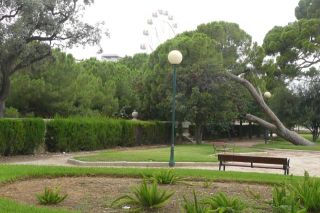Valencia – A Town of Trees
by Edith Haeuser
photographs by Edith Haeuser
Photographs to illustrate the article published in The Mediterranean Garden No 82, October 2015
In her article Edith gives a short but pertinent history of the area around Valencia before arriving at her main theme of trees. She describes the planting of the wide central reservation of one of the main roads.
As an introduction she writes: “….Avenida Blasco Ibáñez, a broad avenue (was) planned at the end of the nineteenth century as the spine of a new garden city with villas on large plots in the first line and more modest housing in the second line on either side of the avenue. Those villas and their gardens have long since disappeared, and the avenue, which was intended to lead to the sea, was never built quite so far. It has an impressive fifty-metre-wide strip in the centre along the first kilometre, on which a park was built for the bourgeoisie to stroll on foot or on horseback, as was so fashionable in Europe at the time.”
Now it is:
“.. a well-maintained park with beautiful mature treesin the middle of quite a busy avenue with two lanes of traffic on either side. The park is divided into long sections by quiet side streets that run across the main axis. Each section is set four steps lower than street level. The perimeters of the sections are accentuated with Platanus × hispanica.”

View along the central section of Avenida Blasco Ibáñez with a row of
Platanus x hispanica on the left and of Melia azedarach on the right,
underplanted with Pittosporum tobira globes and hedges of
Ligustrum ovalifolium

Sophora japonica in flower; this tree was often used for planting in
large towns during the nineteenth century
(Avenida Blasco Ibáñez)

On the right a row of Magnolia grandiflora in front of a Jacaranda mimosifolia,
in the central section Pittosporum tobira globesand hedges of Ligustrum ovalifolium,
in the centre background a Cedrus atlantica with a Populus nigra to its left
(
Avenida Blasco Ibáñez)

A Populus alba viewed from below, revealing the whitish underside of its leaves
(Avenida Blasco Ibáñez)
Leaving Avenida Blasco Ibáñez Edith moved on to two connected parks, the historic Alameda, and the twentieth century Turia Garden.
She writes that the Alameda was: “the favourite esplanade of the Valencians along the left bank of the River Turia in the eighteenth and nineteenth centuries. Originally it was planted with shady elm trees and the poplars (in Spanish álamo) from which it took its name; although those trees have since disappeared, the name is still used.”

View along the Alameda with Pinus pinea, on the very left a Quercus rotundifolia;
at the back the crowns of Pinus pinea planted in the adjacent Turia Garden
with a cypress hedge covering the old retaining wall of the riverbed
The Turia Garden was created after the river Turia was diverted to prevent a repeat of the devastating floods of 1957:
“The original riverbed through the town was gradually turned into a twelve-kilometre-long park with many beautiful trees, sports facilities, cycling paths and the famous cultural centres built by the Valencian architect Santiago Calatrava in the 1990s”

In the foreground the trunk of a Phoenix canariensis underplanted with
Canna indica; further back a Livistona chinensis, also accentuated by a
circular hedge of Pittosporum tobira; on the left a row of Celtis australis;
on the far right treetops in the Turia Garden

An Acacia karroo, underplanted with Canna indica and Pittosporum tobira hedges

View from the Alameda of a group of flowering Ceiba speciosa
(syn. Chorisia speciosa) in the Turia Garden
|


